Experience the OCT difference.
Request your Abbott Sales rep today.
OCT-guided PCI Improved Procedural Outcomes and Safety Results as Demonstrated in ILUMIEN IV,1 OCTOBER2
OCT-guided PCI improved stent implantation results with larger stent area and stent expansion1
OCT reduced procedural complications1:
- Major dissections
- Major malapposition
- Major tissue protrusion
- Untreated focal reference segment disease
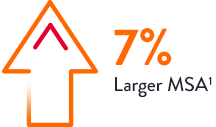
Stent expansion impacts outcomes. Achieving optimal stent expansion (MSA area ≥ 90%) is proven to reduce rates of adverse cardiac events.3 Stent underexpansion is an indicator of adverse events, such as stent thrombosis and restenosis.3
OCT-guided PCI improved safety including reduced stent thrombosis (ST) rates as observed in ILUMIEN IV1,4
- Significant reduction in ST 0.5% vs 1.4%, p=0.02 compared to angiography4
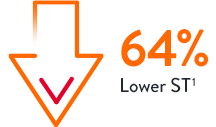
Stent thrombosis is a severe PCI complication that can lead to death or myocardial infarction.5
OCT-guided PCI improved clinical outcomes in complex bifurcation lesions with reduced MACE rates, as demonstrated in OCTOBER2
OCT-guided PCI reduced MACE by 28% compared to angiography2
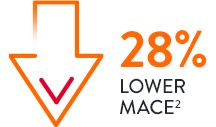
OCT and IVUS showed comparable clinical results in OCTIVUS6
OCT-guided PCI demonstrated comparable results to IVUS-guided PCI in TVF at 1 year.6
- TVF 2.5% OCT vs 3.1% IVUS, p<0.001 for non-inferiority at 1 year
- Fewer major procedural complications in the OCT group (2.2% vs 3.7%)
- Reduced procedural time in the OCT group
- No differences in contrast-related risk between OCT and IVUS
Intravascular imaging to guide PCI is superior to angiography guidance, as demonstrated in the LANCET Network Meta-Analysis7
Routine use of intravascular imaging to guide PCI is superior to angiography and has shown to improve patient outcomes consistently in the network meta-analysis from 22 RCTs and 15,964 patients.7
Imaging guidance leads to lower risk of adverse events across efficacy and safety endpoints.7 Imaging guidance has shown a significant reduction in all-cause death (45%) and all-cause MI (25%).
Image-guided PCI leads to lower risk of adverse events across safety & efficacy endpoints compared to angiography7
Reduction:
45% Cardiac death
18% TV-MI
28% TLR
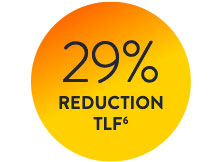
Safety Benefits of Imaging:
48% Reduction ST
25% Reduction all cause mortality
17% Reduction MI

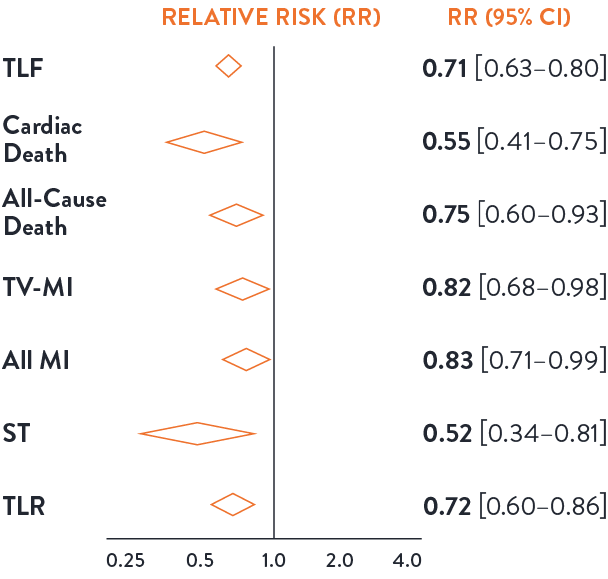
OCT guidance significantly reduces TLF, Cardiac Death and Definite/Probable Stent Thrombosis7
OCT-guided PCI demonstrated 24% reduction in TLF, 39% reduction in Cardiac Death and 53% reduction in definite and probable stent thrombosis, as demonstrated in the LANCET Network Meta-Analysis7
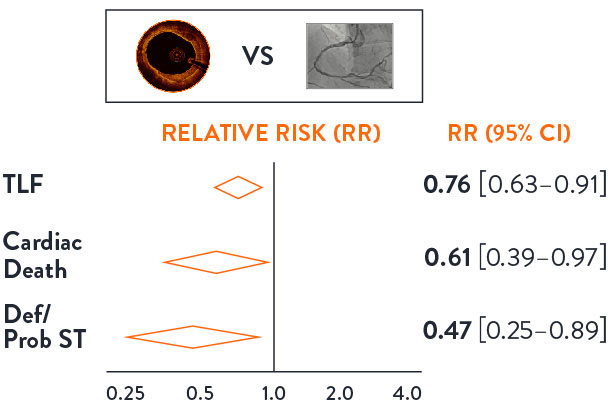
Intravascular Imaging: Can We Still Ignore the Evidence?
Watch Dr. Alasnag review all imaging clinical data presented at the European Society of Cardiology (ESC) 2023.
Imaging matters: new large body of data supports imaging benefit
Intravascular imaging data from over 15,000 patients solidifies the notion that intravascular imaging (IVI) should be the gold standard of care for better patient outcomes.
ILUMIEN IV1
OCT-guided PCI vs. angio-guided PCI in complex cases
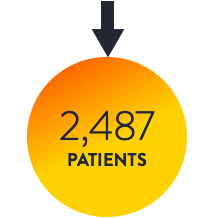
OCTOBER2
OCT-guided PCI vs. angio-guided PCI in bifurcations
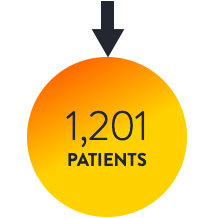
OCTIVUS6
OCT-guided PCI vs. IVUS-guided PCI
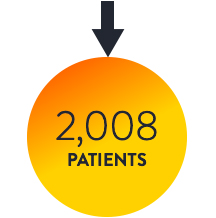
THE LANCET META7
OCT-guided PCI vs. IVUS-guided PCI vs. angio alone
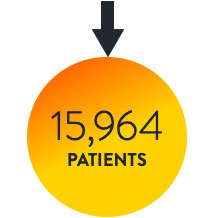
Societies and guidelines recommend imaging guidance for PCI
- 2024 SCAI Expert Consensus Statement on the Management of Calcified Coronary Lesions recommends intravascular imaging in calcified Coronary Artery Disease to assess calcium severity to determine modification strategy, and to understand mechanism of stent failure and calcium distribution in ISR cases.12
- 2023 ESC Guidelines for The Management of Acute Coronary Syndromes recommend intravascular imaging to guide PCI and recommend OCT to guide PCI in patients with ambiguous culprit lesions.8
- 2023 ACC/AHA/SCAI Advanced Training Statement on Interventional Cardiology now require the knowledge of imaging and physiology devices, how to perform imaging-guided PCI as well as the outcomes data to support the use.9
- ACC recommends that operators use IVI as an essential adjunct to angiography, that all US cardiac catheterization labs have IVI capability and national training programs provide training on IVI.10
- The AHA/ACC 2021 Guidelines for use of intravascular imaging were updated and now recommend OCT imaging to guide stent implantation and to determine mechanism of stent underexpansion.11
Clinical Evidence in Detail

References
- Z Ali et al., Optical Coherence Tomography–Guided versus Angiography-Guided PCI, NEJM, DOI: 10.1056/NEJMoa230586
- N.R. Holm et al., OCT or Angiography Guidance for PCI in Complex Bifurcation Lesions, NEJM, DOI: 10.1056/NEJMoa2307770 (OCTOBER)
- Räber L, et al. Clinical use of intracoronary imaging. Part 1: guidance and optimization of coronary interventions. An expert consensus document of the European Association of Percutaneous Cardiovascular Interventions. Eur Heart J. 2018;39(35):3281-3300.
- Z Ali et al., Optical Coherence Tomography–Guided versus Angiography-Guided PCI. ESC2023 Presentation.
- Souteyrand, G. et al. Mechanisms of stent thrombosis analysed by optical coherence tomography: insights from the national PESTO French registry. European Heart Journal, 2016:37:1208-1216.
- D Kang et al., Optical Coherence Tomography-Guided or Intravascular Ultrasound Guided Percutaneous Coronary Intervention: The OCTIVUS Randomized Clinical Trial, 10.1161/CIRCULATIONAHA.123.066429
- Stone, et al., Intravascular Imaging-guided coronary drug-eluting stent implantation: an updated network meta-analysis, The Lancet, doi.org/10.1016/ S0140-6736(23)02454-6
- 2023 ESC Guidelines for the management of acute coronary syndromes. Developed by the task force on the management of acute coronary syndromes of the European Society of Cardiology (ESC). European Heart Journal (2023) 00, 1–107. doi.org/10.1093/eurheartj/ehad191
- 2023 ACC/AHA/SCAI Advanced Training Statement on Interventional Cardiology (Coronary, Peripheral Vascular, and Structural Heart Interventions): A Report of the ACC Competency Management Committee | Circulation: Cardiovascular Interventions. 2023;0:e000088 https://doi.org/10.1161/HCV.0000000000000088.
- Truesdell AG, Alasnag MA, Kaul P, et al. Intravascular Imaging During Percutaneous Coronary Intervention: JACC State-of-the-Art Review. J Am Coll Cardiol. 2023;81(6):590-605. doi:10.1016/j.jacc.2022.11.045.
- 2021 ACC/AHA/SCAI Guideline for Coronary Artery Revascularization: A Report of the American College of Cardiology/American Heart Association Joint Committee on Clinical Practice Guidelines. Circulation. 2022;145:e18–e114. DOI: 10.1161/CIR.0000000000001038.
- Riley, R, et al. SCAI Expert Consensus Statement on the Management of Calcified Coronary Lesions. JSCAI, 2024. https://doi.org/10.1016/j.jscai.2023.101259
MAT-2310266 v4.0
